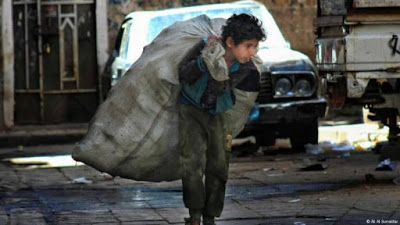Yemeni families in dire straits
 |
| Gouri Sharma & Mohamed Hussein 12.11.2018 |
War, famine and poverty are devastating Yemen. Millions of people are in dire need of food and medical supplies. Among the worst-affected are young mothers and their children.
For the past two months, Fardous Hamran has only been able to give her two children a single meal a day. Relying on food handouts from friends, the 39-year-old manages to feed her 9-year-old son, Sam and 7-year-old daughter, Mayar, a simple meal of traditional Yemeni lahooh bread plus yogurt. Her children are losing weight fast – Sam has lost 3 kilograms (6.6 pounds) within a matter of months.
“I am scared to death thinking that my children will be next to be shown on TV as malnourished children,” she admitted from her home in the capital, Sanaa.
For Safia Abduh, a mother of five, the days in which she packed her children off to school are becoming a distant memory. Her husband, a worker at the Electricity Ministry was among the 500,000 civil servants and government workers whose salaries weren’t paid for two years. Unable to pay the tuition fees for their children’s private education, they transferred them to a nearby public school.
Two years on, after her husband became one of the victims of the ongoing cholera epidemic, two of Abduh’s children are now the main breadwinners in the family. Fifteen-year-old Samir earns less than 1,500 Yemeni rial (€5) a day, for eight hours of work at a plantation for khat, a plant chewed by millions of Yemenis, in the suburbs of Sanaa.

Yemenʹs economic nosedive: “the unprecedented depreciation of the rial in September 2018 proved the most severe blow to the economy since the conflict began,” said Mustafa Nasr, SEMC chairman. “For the first time, Yemenis watched documented reports of citizens eating plant leaves, in spite of the fact that more than $5 billion was spent on humanitarian relief operations over the past three years”
Making ends meet
His 13-year-old brother, Fadhel, spends his days collecting empty plastic bottles from streets and dumpsters and selling them to recycling plants in the city. Between them, they struggle to make €132 a month.
For their 46-year-old mother, their decision to leave school was heart-breaking, but she knew they had no choice. “When they broke the news to me about dropping out of school, I could not stop them,” she said. “There are three other children in need of food.”
Abduh and Hamran’s stories are not unique in Yemen today. Rather, they are becoming the norm in a country where the UN says the crisis has become the worst in the world.
Around 22 million Yemenis, or 75 percent of the population, are in dire need of food, water and medical supplies and nearly 2 million children are severely malnourished.
The war over control of the country between the Houthi militants, said to be backed by Iran, and a coalition of Gulf states led by the government’s regional ally, Saudi Arabia, is entering its fourth year and has pushed one the world’s poorest nations deeper into a humanitarian crisis. Western governments are under increasing pressure to act to avert Yemen’s collapse.
Yemen’s currency crashes
The country’s economy has been hit particularly hard by the war. According to the World Bank, about 40 percent of Yemeni households have lost their main source of income within the past four years, with the poverty rate now up to 80 percent. The economic situation deteriorated further in September, with the rial losing almost two-thirds of its value in less than two weeks.
Mustafa Nasr, chairman of the Studies and Economic Media Center (SEMC), which has just released a new report on Yemen, confirmed that the economy has been in steady decline since war broke out. “The unprecedented depreciation of the Yemeni rial in September 2018 proved the most severe blow to the economy since the conflict began,” he said. “For the first time, Yemenis watched documented reports of citizens eating plant leaves, in spite of the fact that more than $5 billion was spent on humanitarian relief operations over the past three years.”
The loss in value has contributed to a sharp rise in commodity prices. SEMC data, gathered from six Yemeni governorates, including Aden, Taiz and Sanaa, showed that basic foodstuffs such as flour, sugar, rice, cooking oil and milk were 30 percent more expensive than in June 2018 and 92 percent more expensive than in September 2015.
As a result, local food suppliers have been forced to shut. “We cannot sell our goods under this incredible price of the dollar. All the food wholesalers on our street are closing until the exchange rate is fixed. We know that people are suffering, but we cannot risk the sale of goods in light of this collapse, as it puts us at risk in case we suffer setbacks or possibly bankruptcies,” Abdul Razzaq al-Hababi, who owns a warehouse in Sanaa, explained.
Despite the escalating humanitarian situation, fighting has continued between the warring sides and civilian deaths are mounting. In August, Saudi-led airstrikes killed 40 children at a market in the northern province of Saada, pushing the death toll of Yemenis to about 10,000 civilians. Independent watchdogs, however, say that number is likely to be much higher: figures haven’t been updated in years.
Yemen is now split between the Houthis, who control the capital and cities in the north and northwest, while cities including Aden are run by the Saudi-backed exiled government.
Britain and the U.S. are being called on to stop selling arms to Saudi Arabia, as evidence mounts that Western-made weapons are being used against Yemeni civilians.
Gouri Sharma & Mohamed Hussein


